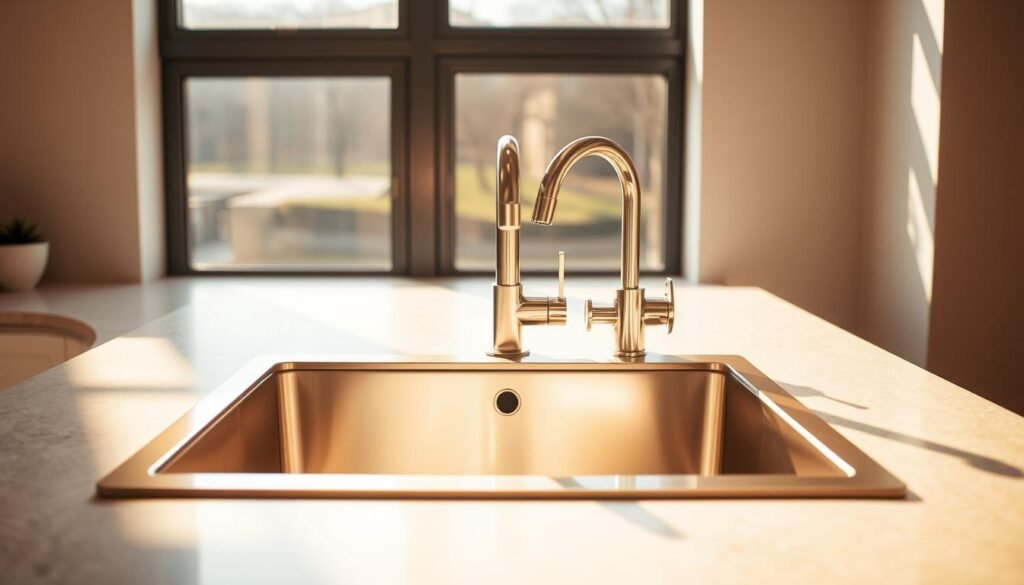
How to Choose a Kitchen Sink? Choosing the right kitchen sink is key in kitchen design. With many options, picking the perfect sink can be tough. A good kitchen sink makes your kitchen both functional and beautiful.
When looking for the perfect sink, size, material, and style matter. Most sinks are 33 or 30 inches. Stainless steel is popular because it’s affordable, durable, and easy to clean.
I’m excited to share what I’ve learned about kitchen sinks. We’ll cover the basics, trends, and designs. Whether you want a single or double-bowl sink, I’ve got you covered.
Key Takeaways
- Choose a kitchen sink that fits your lifestyle and decor
- Consider the size and material of your kitchen sink
- Stainless steel is a popular material for kitchen sinks due to its durability and ease of cleaning
- A perfect kitchen sink can complement the overall aesthetic of your kitchen
- Research and compare different types of kitchen sinks to find the one that suits your needs
- A kitchen sink is a critical element in kitchen design, and selecting the right one can make a significant difference in the functionality and beauty of your kitchen
Understanding Kitchen Sink Basics
Choosing the right kitchen sink is key. You need to know about sink configurations like single, double, and triple basins. Sinks usually range from 24 to 36 inches wide and 18 to 30 inches long. It’s important to understand kitchen sink basics, including standard dimensions and sink configurations.
When looking at kitchen sink basics, think about the sink configurations and their sizes. The size of a kitchen sink is also a big factor. Here are some common sink configurations and what they offer:
- Single basin sinks: often have deeper basins, accommodating larger pots and pans
- Double basin sinks: can be configured in ratios such as 50/50 or 60/40, providing flexibility
- Triple basin sinks: generally wider, taking up more countertop space, and can include a mix of basin sizes
Knowing these kitchen sink basics, including sink configurations and standard dimensions, helps homeowners choose the best sink for their kitchen.
| Sink Configuration | Characteristics |
|---|---|
| Single Basin | Deeper basins, accommodating larger pots and pans |
| Double Basin | Configured in ratios such as 50/50 or 60/40, providing flexibility |
| Triple Basin | Generally wider, taking up more countertop space, and can include a mix of basin sizes |
How to Choose a Kitchen Sink: Essential Factors
To pick the right kitchen sink, think about the essential factors that matter. It’s not just about the style. You need a sink that fits your lifestyle, kitchen design, and what you need it to do.
When picking a kitchen sink, several important things to consider. First, think about the size and configuration of the sink. If you have a big family or often cook for many, a sink with multiple basins might be best. But if your kitchen is small, a single-basin sink could save space.
The material of the sink is also key. Different materials have different benefits. For example, stainless steel sinks are tough and easy to clean. Granite composite sinks look luxurious and feel high-end.
| Material | Durability | Maintenance | Aesthetic Appeal |
|---|---|---|---|
| Stainless Steel | High | Easy | Modern |
| Granite Composite | High | Moderate | Luxurious |
| Cast Iron | Very High | High | Classic |
Lastly, think about the installation method. This affects your kitchen’s look and how it works. Undermount sinks look sleek and modern. Top-mount sinks are easier to install.
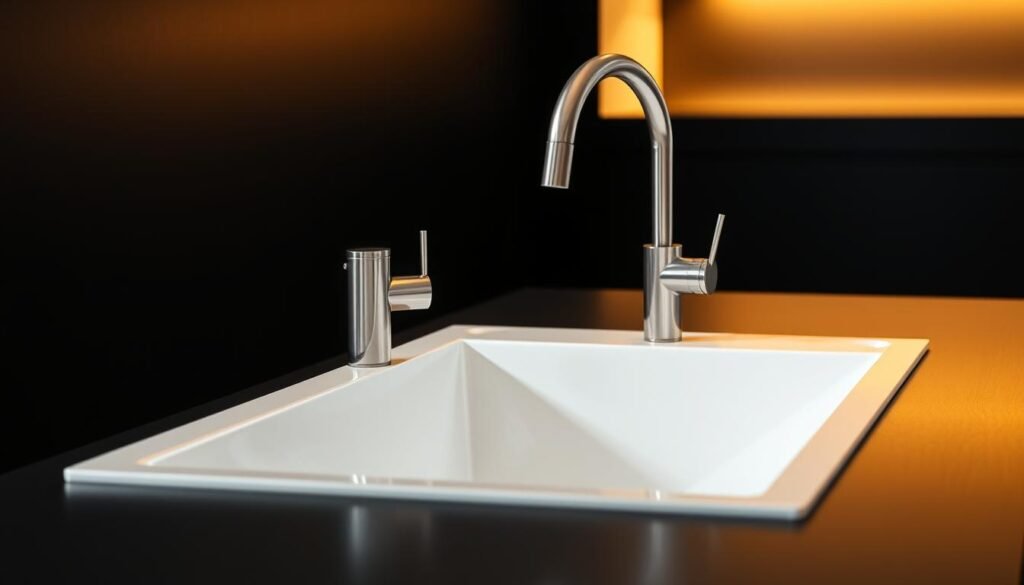
By thinking about these key factors, you can find a kitchen sink that’s both practical and stylish. It will make your kitchen look better and work better, too.
Measuring Your Space Correctly
Choosing the right kitchen sink means measuring your space well. You need to think about the counter depth, cabinet size, and how much room you have. First, measure the current sink and where the plumbing is.
Always measure twice to get the right size before you buy. Subtract 4 inches from the cabinet width and 1 inch from the depth. For example, a 36-inch cabinet can fit a 33-inch sink well.
Kitchen sinks come in sizes like 22-inch, 24-inch, 30-inch, 33-inch, 36-inch, and 45-inch. The 33-inch size is popular for washing big pots and pans. By measuring right, you can find a sink that fits your kitchen perfectly.
- Counter depth: Make sure the sink fits the counter.
- Cabinet size: Pick a sink that matches your cabinet’s size.
- Clearance guidelines: Leave enough room around the sink for easy use.
By following these tips and measuring carefully, you can find a sink that looks good and works well.
| Sink Type | Width Range |
|---|---|
| Single bowl sinks | 22-33 inches |
| Double bowl sinks | 30-48 inches |
| Farmhouse/apron front sinks | 30-40 inches |
Popular Kitchen Sink Materials
Choosing a kitchen sink is a big decision. There are many materials to pick from, like stainless steel, copper, granite composite, and cast iron. Each has its own good points and downsides, fitting different kitchens and users.
Stainless steel sinks are loved for being tough and easy to clean. They also resist heat and stains well, perfect for active kitchens. Copper sinks, on the other hand, stand out for their beauty and fight against bacteria and germs.
Granite composite and cast iron sinks are also favorites. Granite composite is strong against scratches and stains. Cast iron sinks, known for their classic look, can last over 30 years, making them a smart choice.
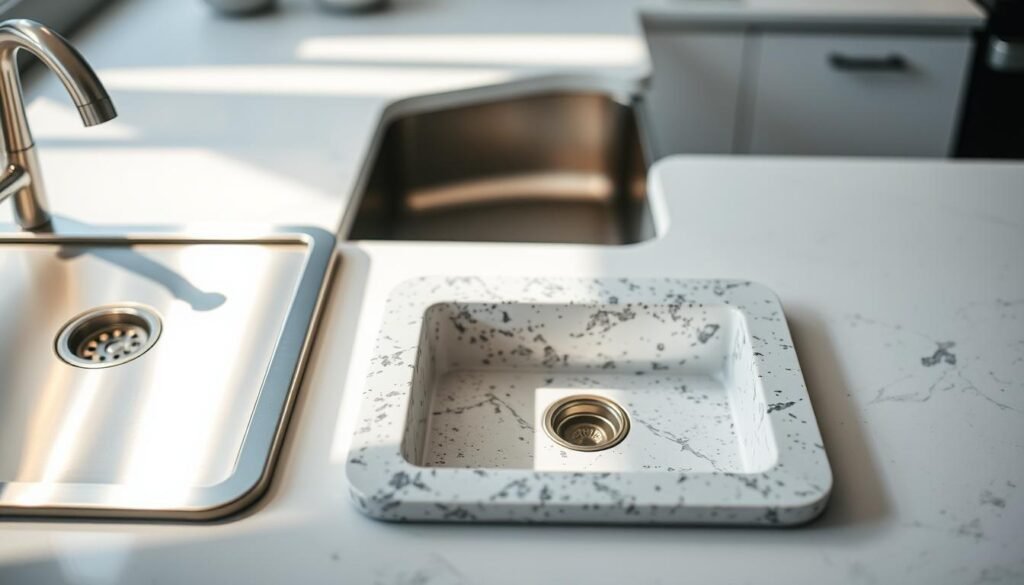
There are many sink designs to pick from, like single bowl, double bowl, and farmhouse sinks. Your choice depends on what you like and your kitchen’s needs. Think about durability, cleaning ease, and looks to find the right sink for your kitchen.
Popular kitchen sink materials offer many benefits, such as:
- Durability and resistance to scratches and stains
- Easy to clean and maintain
- Unique aesthetic appeal and antimicrobial properties
- Long-lasting durability and classic look
Single Bowl vs Double Bowl Design
Choosing between a single bowl sink and a double bowl sink affects your kitchen’s function. Think about your cooking habits, kitchen size, and personal taste.
Advantages of Single Bowl Sinks
Single-bowl sinks are great for big families or those who love to cook and entertain. They have a big basin for large pots and pans, making cleaning simpler. A single bowl sink offers a clear space for washing big items, which is helpful in kitchens where lots of cooking happens.
Benefits of Double Bowl Options
Double bowl sinks are perfect for doing things at once. They let you wash and rinse in different basins. This is great for homes where many people help with meals. Double bowl sinks make things more efficient by letting you do different tasks at the same time.
Choosing Based on Your Needs
When picking between a single bowl and a double bowl sink, think about what you need. Consider your cooking style, the size of your pots and pans, and how you use your kitchen. If you deal with big cookware often, a single-bowl sink might be better. But if you like to multitask while cooking, a double-bowl sink is a good pick.
Understanding Mount Types
Kitchen sink mount types vary, and knowing the differences is key. The mount type affects your kitchen’s look and feel. It’s important to choose wisely.
There are mainly three types: undermount, overmount, and farmhouse. Undermount sinks sit beneath the countertop, giving a sleek look. They are popular in modern kitchens. They are held in place with anchors and adhesive for stability.
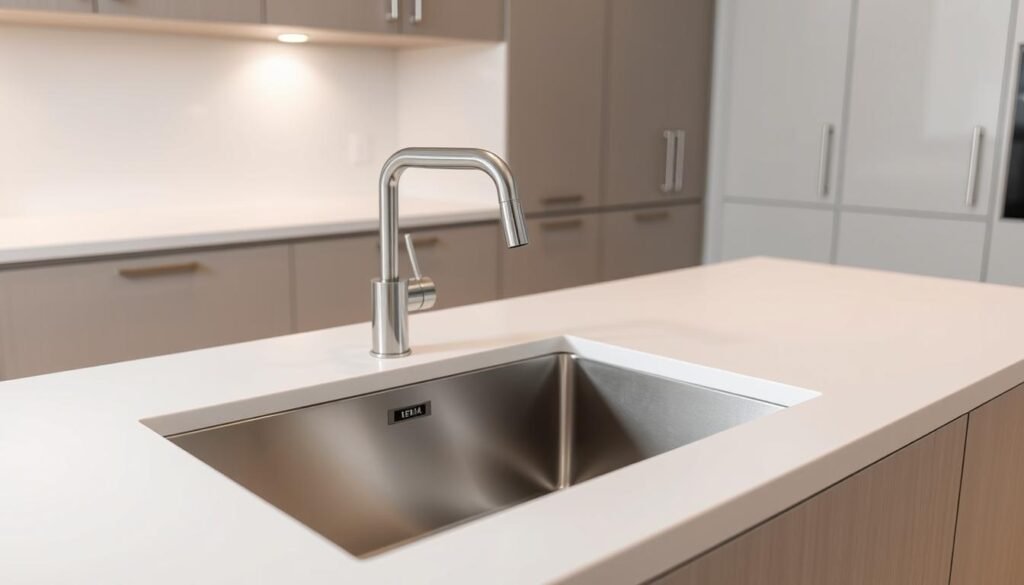
Overmount sinks sit above the countertop. They are simpler to install and offer a traditional look. The sink’s rim rests on the countertop, making it easy to choose.
Farmhouse sinks, or apron sinks, have a large, exposed front. They are great for country-style kitchens, adding a rustic touch. You can choose between undermount and top-mount for farmhouse sinks.
| Mount Type | Installation | Aesthetic |
|---|---|---|
| Undermount | Beneath countertop | Sleek, modern |
| Overmount | Above countertop | Traditional |
| Farmhouse | Varies (undermount or top-mount) | Rustic, country-style |
It’s vital to understand these mount types when picking a kitchen sink. The right choice can enhance both function and style. Whether you like the modern look of an undermount, the classic feel of an overmount, or the rustic charm of a farmhouse, the right mount type matters.
Comparing Sink Depths and Their Uses
Kitchen sink depth is key to functionality. The choice between standard and deep basin sinks depends on your cooking habits and kitchen layout.
Standard Depth Benefits
Standard depth sinks are 8-10 inches deep. They’re great for most homes. They’re comfortable for washing dishes without back strain.
Standard depth sinks are also easier to install. They fit most kitchens without big changes.
Deep Basin Advantages
Deep basin sinks are perfect for large pots and pans. They’re great for avid cooks and entertainers. They offer more space, making kitchen tasks easier.
Choosing between standard and deep basin sinks depends on your needs. Think about your cooking habits and kitchen layout. This will help you pick the right sink depth for your lifestyle.
Kitchen Sink vs Pantry Sink: Key Differences
Choosing a sink for your kitchen can be tricky. You might wonder about the differences between kitchen sinks and pantry sinks. They serve the same purpose but differ in size, function, and how they’re installed.
Kitchen sinks are bigger than pantry sinks. The National Kitchen and Bath Association (NKBA) says a standard kitchen sink is 22 x 24 inches. This size is great for kitchens under 150 square feet. Pantry sinks, being smaller, fit well in butler’s pantries or wet bars.
Size Variations
Kitchen sinks come in many sizes, like single bowl, double bowl, and multi-bowl. Double bowl sinks are popular for big families or when you often have guests. Pantry sinks, being smaller, are perfect for quick food prep and cleanup.
Functional Distinctions
Kitchen sinks are built for heavy use and often have garbage disposals and dishwashers. Pantry sinks are for lighter tasks, like washing veggies or filling water bottles. Knowing these differences helps you pick the right sink for your kitchen.
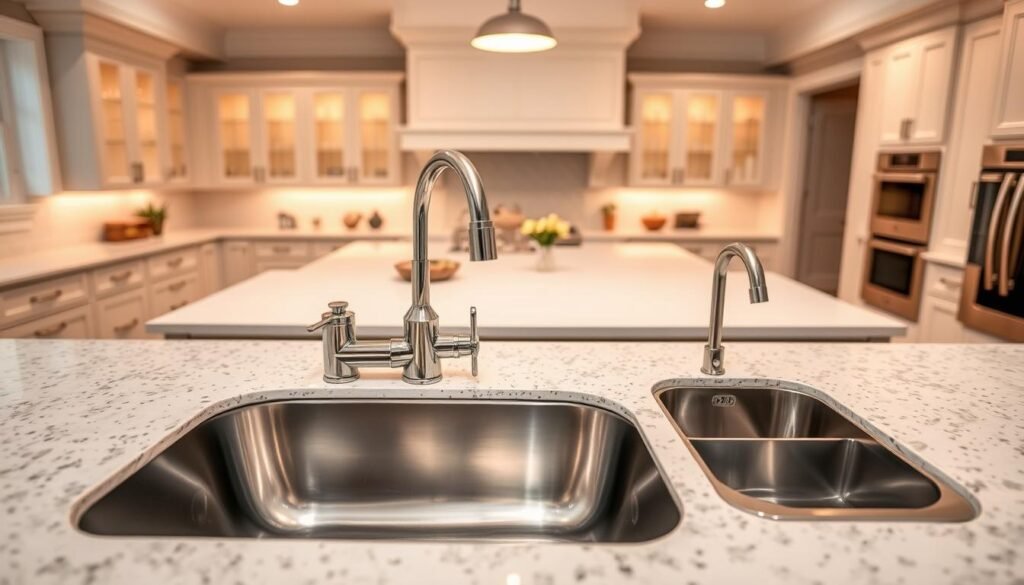
Installation Requirements
Installing kitchen sinks and pantry sinks is different. Kitchen sinks need more work, like plumbing and electrical connections. Pantry sinks are easier to install and don’t need as much complexity. Knowing what’s needed for each sink ensures a smooth installation.
Essential Sink Features to Consider
When picking a kitchen sink, look for key features for the best performance. A well-chosen sink can make your kitchen more useful and efficient.
Some sinks have cool features like built-in drainboards. They give you more counter space and make cleaning up easier. Also, hot water dispensers provide hot water right when you need it. This is great for making tea or instant soups.
- Built-in drainboards for extra counter space and easier cleanup
- Hot water dispensers for instant hot water
- Soap dispensers for added hygiene and convenience
These features boost your kitchen’s functionality and make cooking smoother. Think about what features fit your kitchen’s needs and style when picking a sink.
Budget Considerations and Value
Choosing a kitchen sink means looking at your budget and what it offers. Prices vary a lot, depending on the material, size, and features. Knowing your budget and what you get for it helps you choose wisely.
Price Range Overview
Kitchen sinks come in many prices, from affordable stainless steel to pricey granite composite. Stainless steel sinks are a good deal, lasting long and looking nice without costing too much. But high-end materials offer a fancy look and feel, though they cost more.
Long-term Investment Factors
Think about the sink’s cost over time, too. A sink made from quality materials lasts longer, saving you money on repairs or new ones. Consider durability, upkeep, and how it fits with your kitchen’s style.
By weighing your budget and the sink’s long-term value, you can pick one that improves your kitchen.
Matching Your Sink to Your Kitchen Style
Choosing the right sink is key to a cohesive kitchen design. A sink is more than just a place to wash dishes; it’s a statement piece that can make or break your kitchen’s look.
In modern kitchens, sleek and simple sink designs work best. These sinks have clean lines and a basic shape, often made from stainless steel or matte black. Traditional kitchens, on the other hand, look great with ornate sinks and classic materials like porcelain or copper.
Rustic kitchens are perfect for farmhouse or apron-front sinks. These sinks bring warmth and character, made from durable materials like fireclay or stainless steel. They have a unique front panel that shows off the sink basin.
When picking a sink, think about these key points to match your kitchen style:
- Material: Pick a material that fits your kitchen’s look, like stainless steel for modern or copper for traditional.
- Design: Choose a sink design that fits your kitchen style, whether it’s a sleek undermount or a decorative apron-front sink.
- Finish: Make sure the sink’s finish goes well with your kitchen’s other elements, like faucets and hardware.
| Kitchen Style | Sink Type | Material |
|---|---|---|
| Modern | Sleek Undermount | Stainless Steel |
| Traditional | Ornate Drop-in | Porcelain |
| Rustic | Farmhouse/Apron-front | Fireclay |
By considering these points and picking a sink that fits your kitchen style, you can create a kitchen that looks great and works well. It will also show off your personal taste.
Maintenance Requirements by Material
Keeping your kitchen sink in top shape starts with knowing its material’s needs. Each material has its own care requirements. These can greatly affect the sink’s longevity and appearance.
Daily Care Tips
Every day, your sink needs attention to stay in good condition. For example, stainless steel sinks need regular cleaning to avoid water spots. Wipe them down with a soft cloth and mild soap after each use.
- Copper sinks should not be cleaned with harsh chemicals. Use a gentle cleanser and dry them well to prevent spots.
- Granite composite sinks are tough but might need sealing now and then. Clean them daily with a gentle cleaner.
Long-term Preservation
Preserving your sink for the long haul is more than just daily cleaning. It’s about understanding its specific needs to avoid damage and keep it working well.
Stainless steel sinks are tough against heat and stains, but they can scratch. Using a sink grid can help protect the sink’s bottom.
- Copper sinks get a nice patina over time, which some people like. To keep the shine, polish them regularly.
- Granite composite sinks are hard to scratch and stain, but they can get damaged by hard impacts. Don’t drop heavy things in the sink.
By following these care tips, you can make your kitchen sink last longer and look great.
Common Installation Mistakes to Avoid
To have a smooth kitchen sink installation, knowing common mistakes is key. Installing a kitchen sink can be tricky. Being informed helps avoid costly and frustrating errors.
Improper measurement is a major mistake. You must measure the sink’s size and the plumbing’s location under it. Without this, the sink might not fit right or the plumbing could be off.
Another mistake is inadequate support for the sink. It’s important to make sure the countertop can handle the sink’s weight. Without enough support, the sink can sag or even crack the countertop.
- Ensure accurate measurements of the sink and the space where it will be installed.
- Verify that the plumbing connections are correctly aligned and configured.
- Provide adequate support for the sink to prevent damage to the countertop.
Also, wrong plumbing connections can cause leaks and other problems. It’s important to check the plumbing under the sink to make sure it fits the new sink’s needs.
| Common Mistakes | Consequences | Prevention |
|---|---|---|
| Improper Measurement | Ill-fitting sink, misaligned plumbing | Measure existing sink and plumbing |
| Inadequate Support | Sagging sink, cracked countertop | Reinforce countertop for sink weight |
| Incorrect Plumbing | Leaks, plumbing issues | Verify plumbing connections and config |
Knowing these common mistakes and how to avoid them can lead to a successful kitchen sink installation. This will meet your needs and improve your kitchen’s functionality.
Conclusion: Making Your Final Selection
Choosing the right kitchen sink is more than just picking a design. It involves considering size, material, and how it will be installed. Knowing these basics helps me make a smart choice for my kitchen.
I can pick from single-bowl or double-bowl sinks, and even the material and mount type. Whether it’s stainless steel or fireclay, and undermount or drop-in, I’ll find a kitchen sink that fits my kitchen’s style. I’ll also think about maintenance, installation, and budget to ensure my final selection is a good investment for my home.
The perfect sink is out there, waiting to be found. With the right research and planning, I’m on my way to creating the kitchen of my dreams.
FAQ
What are the common sink configurations?
Common sink configurations include single, double, and triple basin sinks.
What are the standard dimensions for kitchen sinks?
Kitchen sinks usually range from 24 to 36 inches wide. They are 18 to 30 inches long.
What are the essential factors to consider when choosing a kitchen sink?
Important factors include size, material, and how you install it. Think about your lifestyle and how you’ll use the sink.
How do I measure my space correctly to choose the right kitchen sink?
Measure the counter depth and cabinet size carefully. Also, check the plumbing under the sink. Knowing the size of your current sink is key.
What are the popular materials for kitchen sinks?
Popular materials are stainless steel, copper, granite composite, and cast iron. Each has its own benefits and drawbacks.
What are the advantages of single bowl and double bowl kitchen sinks?
Single bowl sinks are great for big families or those who love to entertain. Double bowl sinks are perfect for multitasking, with separate areas for washing and rinsing.
What are the different mount types for kitchen sinks?
Mount types include undermount, overmount, and farmhouse sinks. Each has its own look and installation needs.
How do sink depths differ and what are their uses?
Standard depth sinks work well for most homes. Deep basin sinks are best for those who cook and entertain a lot, providing extra space for big pots and pans.
What are the key differences between kitchen sinks and pantry sinks?
Kitchen sinks are larger and more functional. Pantry sinks are smaller and more specialized, often used in butler’s pantries or wet bars for food prep and cleanup.
What essential features should I consider when choosing a kitchen sink?
Look for built-in drainboards, hot water dispensers, and soap dispensers. These features add convenience and functionality.
How do budget considerations factor into choosing a kitchen sink?
Kitchen sink prices vary a lot, from affordable stainless steel to expensive granite composite. Think about the long-term value the sink will bring.
How important is matching my sink to my kitchen style?
It’s very important to match your sink to your kitchen style for a cohesive look. Modern kitchens often have sleek sinks, while traditional kitchens have more ornate ones. Rustic kitchens usually have farmhouse or apron-front sinks.
What are the maintenance requirements for different sink materials?
Stainless steel sinks need regular cleaning to avoid water spots. Copper sinks need polishing now and then. Granite composite sinks are durable but may need sealing periodically.
What are some common installation mistakes to avoid?
Avoid mistakes like wrong measurements, poor support, and bad plumbing connections. Make sure to measure your current sink and know the plumbing location for a smooth install.
